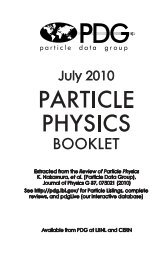30. Passage of particles through matter 1 - Particle Data Group
30. Passage of particles through matter 1 - Particle Data Group
30. Passage of particles through matter 1 - Particle Data Group
You also want an ePaper? Increase the reach of your titles
YUMPU automatically turns print PDFs into web optimized ePapers that Google loves.
<strong>30.</strong> <strong>Passage</strong> <strong>of</strong> <strong>particles</strong> <strong>through</strong> <strong>matter</strong> 9<br />
“The determination <strong>of</strong> the mean excitation energy is the principal non-trivial<br />
task in the evaluation <strong>of</strong> the Bethe stopping-power formula” [10]. Recommended<br />
values have varied substantially with time. Estimates based on experimental<br />
stopping-power measurements for protons, deuterons, and alpha <strong>particles</strong> and on<br />
oscillator-strength distributions and dielectric-response functions were given in<br />
ICRU 49 [4]. See also ICRU 37 [11]. These values, shown in Fig. <strong>30.</strong>5, have since<br />
been widely used. Machine-readable versions can also be found [12]. These values<br />
are widely used.<br />
<strong>30.</strong>2.3. Energy loss at low energies : Shell corrections C/Z must be included<br />
in the square brackets <strong>of</strong> <strong>of</strong> Eq. (<strong>30.</strong>4) [4,11,13,14] to correct for atomic binding<br />
having been neglected in calculating some <strong>of</strong> the contributions to Eq. (<strong>30.</strong>4). The<br />
Barkas form [14] was used in generating Fig. <strong>30.</strong>1. For copper it contributes about<br />
1% at βγ = 0.3 (kinetic energy 6 MeV for a pion), and the correction decreases<br />
very rapidly with increasing energy.<br />
Equation <strong>30.</strong>2, and therefore Eq. (<strong>30.</strong>4), are based on a first-order Born<br />
approximation. Higher-order corrections, again important only at lower energies,<br />
are normally included by adding the “Bloch correction” z 2 L2(β) inside the square<br />
brackets (Eq.(2.5) in [4]) .<br />
An additional “Barkas correction” zL1(β) reduces the stopping power for a<br />
negative particle below that for a positive particle with the same mass and velocity.<br />
In a 1956 paper, Barkas et al. noted that negative pions had a longer range than<br />
positive pions [6]. The effect has been measured for a number <strong>of</strong> negative/positive<br />
particle pairs, including a detailed study with antiprotons [15].<br />
A detailed discussion <strong>of</strong> low-energy corrections to the Bethe formula is given<br />
in ICRU Report 49 [4]. When the corrections are properly included, the Bethe<br />
treatment is accurate to about 1% down to β ≈ 0.05, or about 1 MeV for protons.<br />
For 0.01 < β < 0.05, there is no satisfactory theory. For protons, one usually<br />
relies on the phenomenological fitting formulae developed by Andersen and<br />
Ziegler [4,16]. As shown in ICRU 49 [4] (using data taken from Ref. 16), the<br />
nuclear plus electronic proton stopping power in copper is 113 MeV cm 2 g −1 at<br />
T = 10 keV, rises to a maximum <strong>of</strong> 210 MeV cm 2 g −1 at 100–150 keV, then falls<br />
to 120 MeV cm 2 g −1 at 1 MeV.<br />
For <strong>particles</strong> moving more slowly than ≈ 0.01c (more or less the velocity <strong>of</strong> the<br />
outer atomic electrons), Lindhard has been quite successful in describing electronic<br />
stopping power, which is proportional to β [17]. Finally, we note that at even<br />
lower energies, e.g., for protons <strong>of</strong> less than several hundred eV, non-ionizing<br />
nuclear recoil energy loss dominates the total energy loss [4,17,18].<br />
June 18, 2012 16:19







